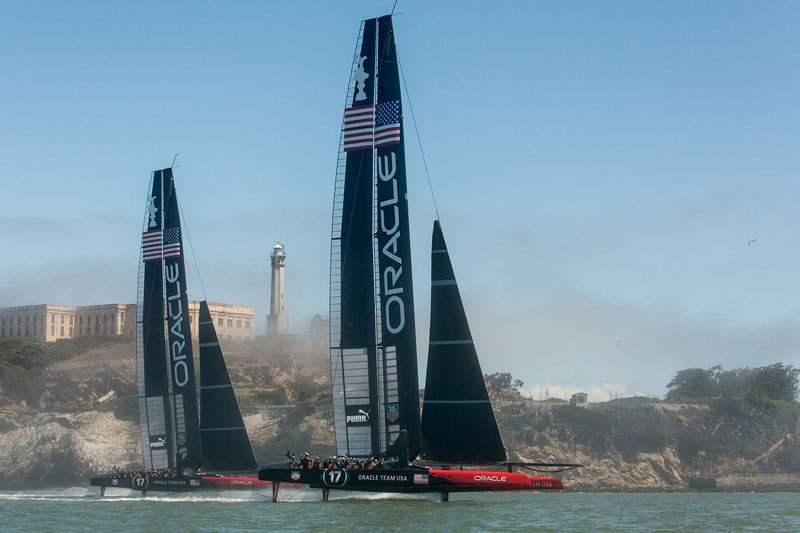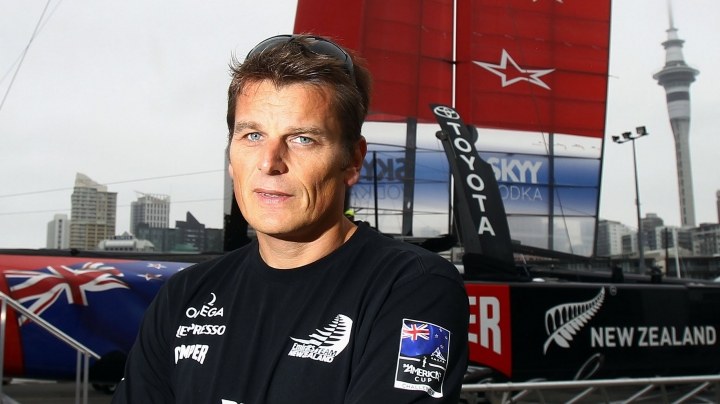
AC Cups Permits, Rudders & Elevators

The U.S. Coast Guard has given the America’s Cup folks the Marine Event Permit required to conduct the America’s Cup on the Bay this summer. It was just in the nick of time, as the fleet parade and time trials will be held on July 5, and the first race of the Louis Vuitton (Challenger) Cup is slated for July 7. (Find the full schedule for Opening Weekend HERE.)
We’re assuming that the Louis Vuitton will go off on the 7th, but given the litigious nature of the America’s Cup, we’ll believe it when we see it. Indeed, the Emirates New Zealand team has already filed a protest with the International Jury, one that will be heard on July 8.
The Marine Event Permit was predicated on the implementation of the 37-point Safety Plan created after the death of Artemis’ Andrew Simpson. Most of the syndicates don’t have a problem with most of the new requirements — except the Kiwis and others when it comes to the three points of the Safety Plan that deal with rudders and elevators.
When the AC72 class was created, it was based on the assumption that the cats wouldn’t plane. But the Kiwis spent thousands of hours figuring out a way around it. Once they got foiling, everybody had to catch up. Some (Oracle) did it more quickly than others (Artemis).
The deal with foiling is that the more you can control the pitch, the less likely your chances of pitchpoling at 40 knots. The Kiwis say they have managed to figure out a way to do it within the parameters of the original AC72 design that has been proven safe in more than 60 days of sailing. But that it required them to make some compromises to the structure and such that weren’t in the best interests of performance.
That said, most people agree that they AC72s could be safer if the rudders were allowed to be deeper and the elevators larger than was permitted in the original design parameters. Oracle has apparently been working on the assumption that deeper rudders and bigger elevators will be allowed, which may have allowed them to have leapfrogged the understandably angry Kiwis in this critical design area.
It’s easy to side with the Kiwis, who argue that it’s unfair to change the design rules so late in the game. But with one America’s Cup death already, and everyone acknowledging that the AC72s are way overpowered and dangerous on the Bay, it’s hard to argue against anything that promotes safety.
Aussie Iain Murray, the Independent Director for the America’s Cup, explained why he included the controversial three points when applying for the Marine Event Permit:
“I have exercised my professional judgment to the best of my ability, and have weighed carefully the unfortunate circumstances thrust upon us including (as a paramount consideration) the need to increase the safety of our crews, the officials and other Bay users, as well as the investment made by Competitors and all other stakeholders in this event. Safety is not a multiple-choice selection from which Competitors pick and choose. I have issued this Regatta Notice as being in the best collective interests of the America’s Cup as a long-standing institution in and at the pinnacle of our sport.”
For those interested in the minutia of all this, Emirates Team New Zealand skipper Dean Barker took a crack at it in his June 30 blog:
"There has been a lot of discussion in the media centred mainly around the issue of the rudder and rudder elevators. In the AC72 Class Rule you are allowed to build rudder elevators which are not allowed to exceed the maximum beam of the yacht, nor extend aft of one metre forward of the stern plane of the yacht. The AC72 class was never envisioned to fully foil, however through 1000s of hours of design and testing we made a decision that our first AC72 would be a fully foiling yacht.

"To do this we needed to increase the engineering of a number of components of the boat to accept the extra loading as a boat comes clear of the water. We also took design compromises to allow us to build a boat which would foil in a stable and reliable fashion. The compromise was often straight line speed, but a compromise we felt necessary for safety and the ability to push the boat hard.
"The Safety Recommendations included a number of points regarding the rudders and rudder elevators. The main ones were imposing a minimum rudder length of 2.1m, introducing a minimum elevator area of 0.32m2, removing the maximum beam rule which effectively allows the elevators to extend outside the beam of the boat, and insisting the elevators must be symmetrical in plan view.
"We agree with imposing a minimum length of rudder even though this made one of our set of rudders illegal. We also thought it was sensible to impose a minimum elevator area. However, we are completely opposed to allowing elevators to extend outside of maximum beam and having to be symmetric.
"Allowing the rudder elevators to extend outside of max beam is incredibly dangerous and introduces serious risk for the crew. If a crew member was to fall overboard from either hull while the boat is foiling, there is a much greater chance they would be struck by the longer elevator and this would lead to a serious injury. As the rule is currently written, with the elevators limited to maximum beam, the chance of injury is greatly reduced.
"The second point we are completely opposed to is having to make the elevators symmetric in plan view. We took a clear compromise when designing our boat to position our rudder bearings to allow us to build an elevator to the size we felt necessary. With the existing class rule it is possible to build an elevator well in excess of the imposed minimum area. From day one of sailing our AC72 yachts, we have sailed with asymmetric elevators.
"We have now done well over 60 days with these elevators and have never had a structural issue with either rudders or elevators. It is completely unnecessary to impose the requirement for the elevators to be symmetric in plan form. There is no logical argument to say that asymmetric elevators are not safe."
Ted Hood Passes Away
Sailing icon and pioneer Ted Hood passed away on Friday at the age of 86. Founder of Hood Sails, Hood Yacht Systems and Ted Hood Yacht Designs, he skippered 1974’s winning America’s Cup boat, Courageous, after supplying sails to many winning AC boats for nearly two decades. He went on to design a number of popular boats, and was responsible for the development of the modern roller furler. The list of his accomplishments would go on far too long for this space — we recommend reading his obituary on TedHood.com — and to say he influenced our sport is the understatement of the year. He will be missed by many, and a celebration of his life will be held in Newport, RI later in the summer.
Emergency Recall of Lite Propane Tanks
In late May, the Department of Transportation issued an emergency recall of composite propane tanks made by The Lite Cylinder Company. The tanks are easily identified by their plastic outer case and translucent inner epoxy tank. The recall noted several cases where the tanks ruptured, and one documented case of an injury.
Shortly after the recall was issued, the company closed its Franklin, Tennessee manufacturing facility and essentially told distributors and tank owners to take a flying leap. "The company is financially insolvent and will not be able to recompense cylinder owners, dealers and distributors for the expenses incurred in complying with this Emergency Recall Order," they said in an email to retailers.
Tanks with the following markings are the subject of the recall: DOT-SP 14562, DOT-SP-13957 and DOT-SP 13105. (Note that the recall only applies to Lite Cylinder tanks, not Trident or any other manufacturer’s product.) The order requires consumers and distributors to return the affected tanks to Lite’s facility, which is now closed. Since they can’t be filled, moved or used legally, customers are stuck with holding on to them until further notice.
There are more than 55,000 affected tanks out in the wild, including on many boats. Unfortunately, if you own one, not only is the tank potentially dangerous, but it’s also useless as it’s now illegal to fill or even use them. It’s unlikely a consumer would be prosecuted for using one, but they could get blown to bits and that would ruin just about any cruise-out!
AC Bits from Peyron and Cayard
- The May 9 incident in which Artemis capsized and broke apart was, in the words of Loïck Peyron, a "classic capsize situation." Peyron, a Frenchman who is perhaps the most experienced and successful big multihull racer in the America’s Cup, is one of the two helmsmen for Artemis and was following the cat in a chase boat at the time of the accident.
- Peyron said that contrary to some reports, Artemis did not break up before she capsized. He told the Times that the red cat was bearing away, which has proven to be very tricky for the AC72s, but there was "a bit too much wind" and the cat didn’t have enough lifting force from the foil or daggerboards. So she pitchpoled. He said that Artemis broke "during" the capsize, not before.
- Crewman Andrew ‘Bart’ Simpson was not killed because he was trapped beneath the cat’s net, Peyron said, but rather "between the beams and the wing." He did not reveal the exact cause of death.
- The 53-year-old Peyron said it was "unacceptable" that the boat would break, and that the crew lost a friend "because of a structure failure."
- Peyron said that part of the problem was that the shape of the beam itself "was not exactly the best one." But he did say it was well built. The boat was designed by Argentinian Juan Kouyoumdjian, who has spent most of his career designing monohulls.
- Artemis CEO Paul Cayard told the Times that unlike the other AC72s, Artemis, which was on her last sail, was not a fully hydrofoiling cat. The new Artemis will be.
- Artemis has 130 employees, but Cayard said that there have "only been a few departures from the team" following the death of Simpson. Cayard didn’t give a specific number or name any names or job descriptions.
- Peyron is not completely satisfied with how the Cup is proceeding. Specifically, he said that he thought the new wind speed limits — dropped down to just 20 knots for the first phase of the challenger series — was still too high, and that the five-minute window for measuring the wind speed was too long. According to the Times, Peyron also believes that more can be done to make the big cats easier to steer. We presume he was talking about elevators, but he wasn’t specific.
- Peyron has previously said that the AC72s are too big and are overpowered for San Francisco Bay. As we mentioned, he is probably the most experienced and most successful big multihull racer in the America’s Cup. Nonetheless, he thinks the event needs to go on.
- Cayard told the Times that even though he, like Peyron, had been in a chase boat, he was in a ‘position of responsibility’, as was helmsman Nathan Outteridge and skipper Iain Percy, the latter being Simpson’s partner in winning a Gold Medal in the Star class at the London Olympics. "We all were [in positions of responsibility]," said Cayard.
